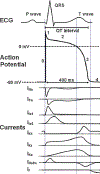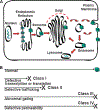Rescue of mutated cardiac ion channels in inherited arrhythmia syndromes
- PMID: 20224422
- PMCID: PMC6287643
- DOI: 10.1097/FJC.0b013e3181dab014
Rescue of mutated cardiac ion channels in inherited arrhythmia syndromes
Abstract
Inherited arrhythmia syndromes comprise an increasingly complex group of diseases involving mutations in multiple genes encoding ion channels, ion channel accessory subunits and channel interacting proteins, and various regulatory elements. These mutations serve to disrupt normal electrophysiology in the heart, leading to increased arrhythmogenic risk and death. These diseases have added impact as they often affect young people, sometimes without warning. Although originally thought to alter ion channel function, it is now increasingly recognized that mutations may alter ion channel protein and messenger RNA processing, to reduce the number of channels reaching the surface membrane. For many of these mutations, it is also known that several interventions may restore protein processing of mutant channels to increase their surface membrane expression toward normal. In this article, we reviewed inherited arrhythmia syndromes, focusing on long QT syndrome type 2, and discuss the complex biology of ion channel trafficking and pharmacological rescue of disease-causing mutant channels. Pharmacological rescue of misprocessed mutant channel proteins, or their transcripts providing appropriate small molecule drugs can be developed, has the potential for novel clinical therapies in some patients with inherited arrhythmia syndromes.
Conflict of interest statement
The authors have no conflicts of interest to disclose.
Figures



Similar articles
-
hERG potassium channels and cardiac arrhythmia.Nature. 2006 Mar 23;440(7083):463-9. doi: 10.1038/nature04710. Nature. 2006. PMID: 16554806 Review.
-
Biology of cardiac arrhythmias: ion channel protein trafficking.Circ Res. 2004 Jun 11;94(11):1418-28. doi: 10.1161/01.RES.0000128561.28701.ea. Circ Res. 2004. PMID: 15192037 Review.
-
Reconstitution of defective protein trafficking rescues Long-QT syndrome in zebrafish.Biochem Biophys Res Commun. 2011 May 6;408(2):218-24. doi: 10.1016/j.bbrc.2011.03.121. Epub 2011 Mar 31. Biochem Biophys Res Commun. 2011. PMID: 21458413
-
Pharmacogenetics and cardiac ion channels.Vascul Pharmacol. 2006 Feb;44(2):90-106. doi: 10.1016/j.vph.2005.07.013. Epub 2005 Dec 15. Vascul Pharmacol. 2006. PMID: 16344000 Review.
-
Sodium channels as macromolecular complexes: implications for inherited arrhythmia syndromes.Cardiovasc Res. 2005 Aug 15;67(3):448-58. doi: 10.1016/j.cardiores.2005.04.003. Cardiovasc Res. 2005. PMID: 15919069 Review.
Cited by
-
In silico screening of the impact of hERG channel kinetic abnormalities on channel block and susceptibility to acquired long QT syndrome.J Mol Cell Cardiol. 2015 Oct;87:271-82. doi: 10.1016/j.yjmcc.2015.08.015. J Mol Cell Cardiol. 2015. PMID: 26859003 Free PMC article.
-
Determination of the Relative Cell Surface and Total Expression of Recombinant Ion Channels Using Flow Cytometry.J Vis Exp. 2016 Sep 28;(115):54732. doi: 10.3791/54732. J Vis Exp. 2016. PMID: 27768059 Free PMC article.
-
Mechanism of loss of Kv11.1 K+ current in mutant T421M-Kv11.1-expressing rat ventricular myocytes: interaction of trafficking and gating.Circulation. 2012 Dec 11;126(24):2809-18. doi: 10.1161/CIRCULATIONAHA.112.118018. Epub 2012 Nov 6. Circulation. 2012. PMID: 23136156 Free PMC article.
-
Structure-activity relationships of pentamidine-affected ion channel trafficking and dofetilide mediated rescue.Br J Pharmacol. 2013 Jul;169(6):1322-34. doi: 10.1111/bph.12208. Br J Pharmacol. 2013. PMID: 23586323 Free PMC article.
-
Connexin 43 and CaV1.2 Ion Channel Trafficking in Healthy and Diseased Myocardium.Circ Arrhythm Electrophysiol. 2016 Jun;9(6):e001357. doi: 10.1161/CIRCEP.115.001357. Circ Arrhythm Electrophysiol. 2016. PMID: 27266274 Free PMC article. Review. No abstract available.
References
-
- Jervell A, Lange-Nielsen F. Congenital deaf-mutism, functional heart disease with prolongation of the Q-T interval and sudden death. Am Heart J 1957;54:59–68. - PubMed
-
- Romano C, Gemme G, Pongiglione R. [Rare cardiac arrhythmias of the pediatric age. Syncopal attacks due to paroxysmal ventricular fibrillation.]. Clin Pediatr (Bologna) 1963;45:656–683. - PubMed
-
- Ward OC. A new familial cardiac syndrome in children. J Ir Med Assoc 1964;54:103–106. - PubMed
-
- Selzer A, Wray HW. Quinidine syncope. Paroxysmal ventricular fibrillation occurring during treatment of chronic atrial arrhythmias. Circulation 1964;30:17–26. - PubMed
-
- Noda M, Ikeda T, Suzuki H, et al. Expression of functional sodium channels from cloned cDNA. Nature 1986;322:826–828. - PubMed
Publication types
MeSH terms
Substances
Grants and funding
LinkOut - more resources
Full Text Sources
Medical

